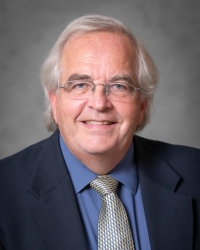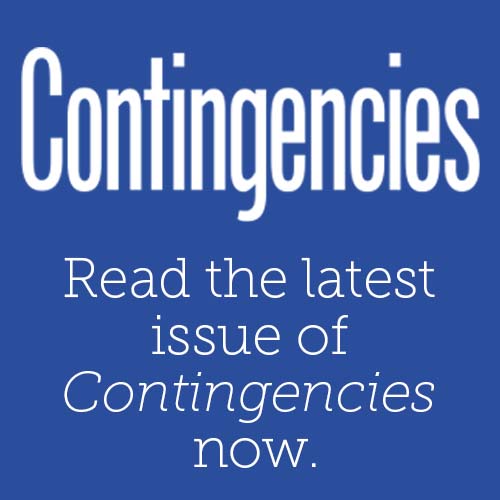Steve Alpert Farewell Remarks

Farewell Remarks of 2017-18 Academy President Steve Alpert at the American Academy of Actuaries Annual Meeting and Public Policy Forum in Washington, D.C. on Nov. 1, 2018
Alpert: Congratulations, Elise, and on behalf of the Academy and the entire profession, once again thank you for your public service.
A year ago, I introduced myself and my family connection to the Academy – including my father’s status as a charter member and my second-grade prediction of my career choice.
Well, apparently, my wife’s family has a particularly strong affinity for actuaries. While visiting a cousin of hers in Amsterdam following the spring International Actuarial Association meeting in Berlin, I discovered that her cousin’s husband was a direct descendant of Rehuel Lobatto, a Dutch statistician, mathematician, and proto-actuary.
Those of you who were math majors may recognize the name as part of the Gauss-Lobatto quadrature method for estimating the integral of complex functions that can be approximated by a polynomial. Rehuel spent the early part of his career exercising his actuarial talents as the commissioner of weights and measures in Delft, eventually becoming a professor of mathematics and statistics at the Royal Academy of Delft.
In 1829-1830, as a government consultant on life insurance (an industry that was emerging around the world in the early 1800s), he published a pair of pamphlets – “Consideration of the nature, the advantages and the constitution of life insurance companies: including an explanation of the true grounds of calculation to the design of durable widows' funds” and “About the deployment and calculation of sustainable orphan funds.”
If there are any Dutch speakers here, my apologies; I did the best I could with Google Translate. In both cases, Lobatto was acutely aware of his target audience, appending to each title the phrase: “specially drawn up for the untrained in mathematics.”
The second, shorter pamphlet on the orphan funds includes tables, commutation functions, and a simplified example of how to use them to price and reserve insurance that provides an income benefit until an orphaned child reached age 21. And, in a public policy message aimed at “the untrained in mathematics,” much the way Academy issue briefs target a broader, non-actuarial audience, he included the roll forward of two sample funds to demonstrate that the present value math works whether the policies had single or annual premiums.
Just as Rehuel had the perspective to identify the public interest in stable and sustainable financial security programs, a year ago I challenged you to also have that perspective and use your training and professionalism to make the “right call” in the public interest.
Over a half-dozen Contingencies articles, including one published today, we have explored the dimensions of the “public interest” – from the public’s expectations for governance of the profession, to the value the profession brings to the public, the importance of independence and objectivity in balancing fairness and security needs and building trust, and how both Academy and individual actions are necessary to build and sustain that trust.
The strength of our profession rests on a triad of three separate, but in many ways interdependent, elements, each of which is connected to the other two:
- The first is education and research that provides actuaries with the tools needed to understand and advise principals, policymakers, and the public about all the dimensions of financial security programs.
- The second element is actual practice — how actuaries can make effective use of their tools and skills to provide value to principals and articulate the guardrails that serve the public interest.
Completing the triangle, we have the independent and objective standards of conduct, qualification, and practice that assure the public that actuarial skills and tools are being applied with honesty and integrity and in a high-quality way that protects the public interest.
In the U.S., separate organizations each specialize in one of these elements, and each organization pursues its mission vigorously. For example, I was privileged to attend the recent annual meetings of both the Society of Actuaries and the Conference of Consulting Actuaries. At both meetings, each of the Presidents – both retiring and incoming – clearly outlined his organization’s unique mission and the organizational successes that have contributed to the success of the actuarial profession. The resulting diversity of perspective, dialogue and exchange of ideas makes us all better and stronger.
For its part, the Academy also continues to have great success in advancing its goals to be the objective, independent and effective professionalism and public policy voice.
For example, on Jan. 17th, the Academy and the Canadian Institute of Actuaries hosted the joint webinar, “The Roles of Professional Actuarial Organizations in the United States and Canada,” examining how we continue to meet the ongoing, critical public service and professionalism needs the organizations were established to fulfill.
The Academy actively provided objective input to policymakers on Capitol Hill and in the states on diverse topics:
- The Academy hosted a Capitol Hill briefing on the drivers of growth in prescription drug expenses, benefits vs. costs for new treatments, the impact of high and increasing prescription drug costs on payers, and options to address spending.
- The Academy was asked to testify before a congressional joint select committee, and provided written follow-up answers, on the history and structure of the multiemployer pension plan system, and the hard choices – and consequences – that will be needed to solve the looming funding crisis that distressed plans face. In this case, the Academy’s participation was invited specifically because of our independence and the fact that we were not aligned with any industry groups. The Academy continues to be asked for input by the committee on this important work.
- Life Practice Council members assisted regulators with recalibrating risk-based capital calculations for life insurers to properly reflect the year-end 2017 changes in the tax law or improve the way insurers build longevity risk into their RBC ratios.
The Academy also continues to be at the forefront of stimulating wide-ranging discussions on new and emerging public policy issues. In addition to the broad span of plenary and breakout sessions at this meeting, I’d like to highlight a few additional examples of the prolific contributions of our volunteers over the year:
- In the spring and early summer, we sponsored discussions and developed tools on lifetime income and modernizing the U.S. retirement system – closing the gap between Americans’ lifetime income needs and a retirement system that hasn’t kept up with demographic, economic, personal savings and other trends.
- We released our monograph, Big Data and the Role of the Actuary, at the International Congress of Actuaries meeting in Berlin on June 5th. The monograph examines how actuarial professionalism intersects with the powerful analytical tools of Big Data. Our Big Data Task Force is also engaging regulators and policymakers who are trying to better understand this work. We’ll hear more about Big Data tomorrow at breakfast.
- Just two months ago, we published an additional monograph, Travel Insurance: An Actuarial Perspective, drawing on actuarial expertise to provide a clear explanation of what coverage travel insurance may or may not provide, how travel insurance differs from other types of insurance, and the public policy considerations involved in regulating this unique line of insurance.
And, The Magic School Bus Takes a Risk: A Book About Probability, aimed at third to fifth graders and released at last year’s annual meeting, has sold more than 2,000 individual copies, many from actuaries who are themselves donating copies to favorite schools in their communities. The book has received rave reviews from everyone who has seen it, and has helped young people with math literacy, understanding their place in their communities and appreciating what it means to be an actuary. Just looking at the smiles in our photo album tells you all you need to know!
Of course, amidst all the big things that the Academy accomplished this year, our membership continues to grow, demonstrating widespread support for our twin missions of serving the public and the actuarial profession.
As I close out my presidential year, I want to personally thank our more than 1,200 volunteers for your great work, dedication and passion for the profession, professionalism and delivering high quality objective and effective public policy advice.
I also want to express my appreciation to the Academy’s Board and Executive Committee – individually and collectively. They are by far the deepest thinking, best-listening and most strategically-focused board of any membership organization that I have been involved with. Without their sincere engagement and strategic thoughtfulness, we could not have accomplished nearly half as much.
And of course, our volunteer efforts might all be in vain if it weren’t for the Academy staff’s ability to remind us where the true north of our mission lies and to keep the machinery of production and communication well-oiled and smoothly functioning.
And finally, a big thank-you to my family: My daughters Naomi — who is presenting at a meeting of her own today — and Lauren who is here today with her husband Arthur. All three are self-described math nerds (as am I), and have reminded me continuously since I was announced as president-elect 2-½ years ago to enjoy my time in what they see as the coolest job ever. And, to my wife, Sharon, for keeping my outlook grounded, for putting up with my travel schedule, and for diligently trying to remember which group of people she’s likely to encounter at the different meetings we attend together.
In summary, the past year has demonstrated that the Academy and its members are well-prepared and positioned to deliver objective, independent, and effective advice to policymakers as well as high professional standards of actuarial qualification, practice, and conduct. As we prepare for Shawna’s inauguration as the next president of the American Academy of Actuaries, this referee has just one thing left to say:
“Game on!”
Share







